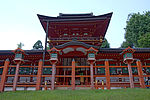Ame-no-Koyane
| Ame-no-Koyane | |
|---|---|
God of Divine Mirror, Great Divination, Divine Affairs | |
| Japanese | 天児屋命 |
| Major cult center | |
| Texts | Kojiki, Nihon Shoki, Izumo-no-kuni Fudoki |
| Genealogy | |
| Parents | Kamimusubi (Kogo Shūi), Kogotomusuhi (Nihon Shoki) |
| Children | |
Ame-no-Koyane-no-mikoto (天児屋命, 天児屋根命) is a kami and a male deity in Japanese mythology and Shinto. He is the ancestral god of the Nakatomi clan, and Fujiwara no Kamatari, the founder of the powerful Fujiwara clan.[4] An Amatsukami, 'Kami of heaven', he resides in Takamagahara.
Mythology
According to Kogo Shūi and Kashima Shrine's genealogy, Ame-no-Koyane is the son of the creator deity Kamimusubi, one of the first three gods to come into existence.[5][6] However, according to Nihon Shoki, he is the son of Kogotomusubi (興台産霊命).[5]
According to Nihon Shoki, Ame-no-Koyane was "the first in charge of divine affairs, for which reason he was made to serve by performing the Greater Divination." He was commanded by Amaterasu to guard the divine mirror, and was known as the "Imperial Aide" at the Imperial Palace, being in charge of divine affairs of the palace.[5]
According to Japanese mythology, Ame-no-Koyane performed a ritual prayer to the sun goddess Amaterasu to call her out of the cave of Ama-no-Iwato and bring light back to the world, after Susanoo, the god of storms, drove her away.[4] During tenson kōrin, he acted as one of the five gods descending from heaven accompanying Ninigi, thus becoming the ancestor of the Nakatomi clan.[7]
Shrines
Ame-no-Koyane is worshipped at:
- Hiraoka Shrine
- Kasuga Grand Shrine
- Ōharano Shrine
- Yoshida Shrine
- and all Kasuga Shrines in Japan.
References
- ^ Suzuki, Matoshi. Izu Sukune Keizu Hyakkakeizuko「伊豆宿禰系図」『百家系図稿』1st book
- ^ a b Shibata, Joue. Saitama Sōsho. (1929) Volume 1: Chichibu Shi, p 111, Chichibu hikomikoto o keizu 『埼玉叢書. 第1巻』内『秩父志』内111頁「秩父彦命御系図」. Sanmeisha
- ^ Nakata. Akahori, Aoki, Hori-shi: Shokeifu, 3rd book「赤堀、青木、堀氏」『諸系譜』
- ^ a b Mypaedia, Amenokoyane. Japan: Heibonsha. 1995. OCLC 38516410.
- ^ a b c "Encyclopedia of Shinto: Kami in Classic Texts: Amenokoyane". Kokugakuin University. Establishment of a National Learning Institute for the Dissemination of Research on Shinto and Japanese Culture. Archived from the original on 2006-05-08. Retrieved 2021-03-27.
- ^ Tanaka. Kashima Daiguji Keizu, Shokeifu「鹿嶋大宮司系図」『諸系譜』. Vol. 1. Japan.
- ^ Ueda, Masaaki (2001). Nihon Jinmei Daijiten, Amenokoyane. Japan: Kōdansha. ISBN 4062108003. OCLC 50718841.
External links
- Shinto Portal - IJCC, Kokugakuin University - Encyclopedia of Shinto
- Ameno Koyane - History of Japan Database



